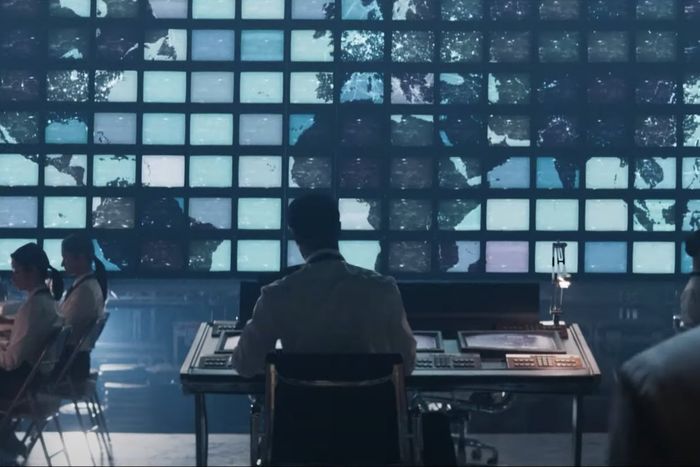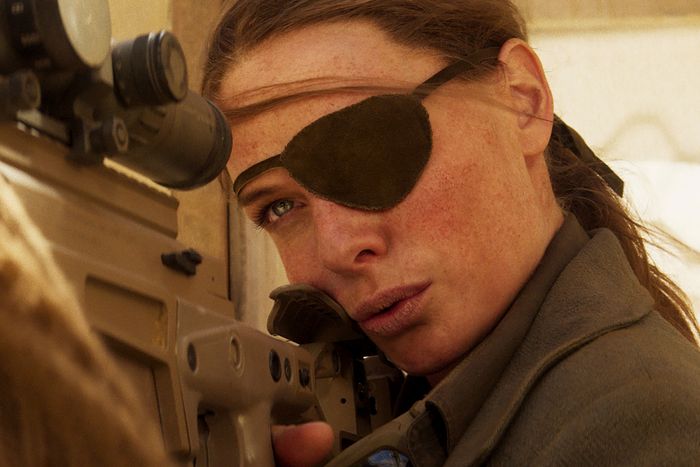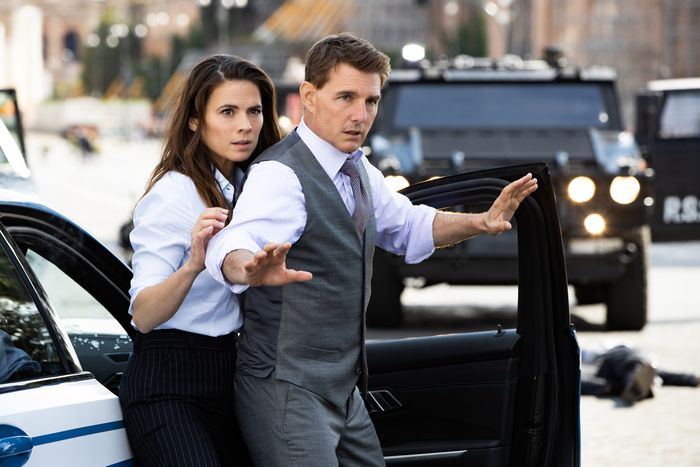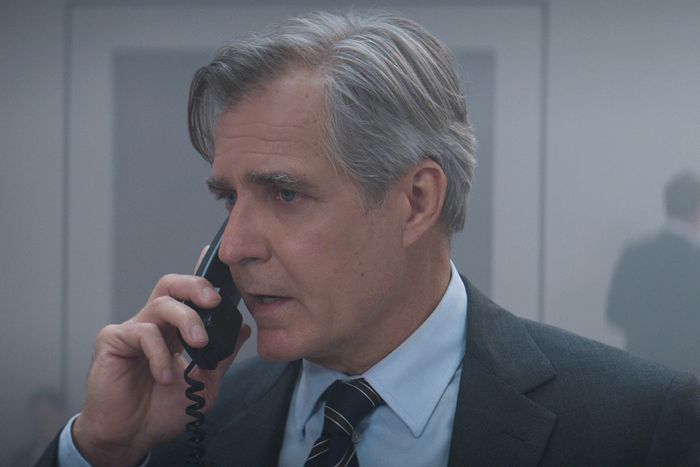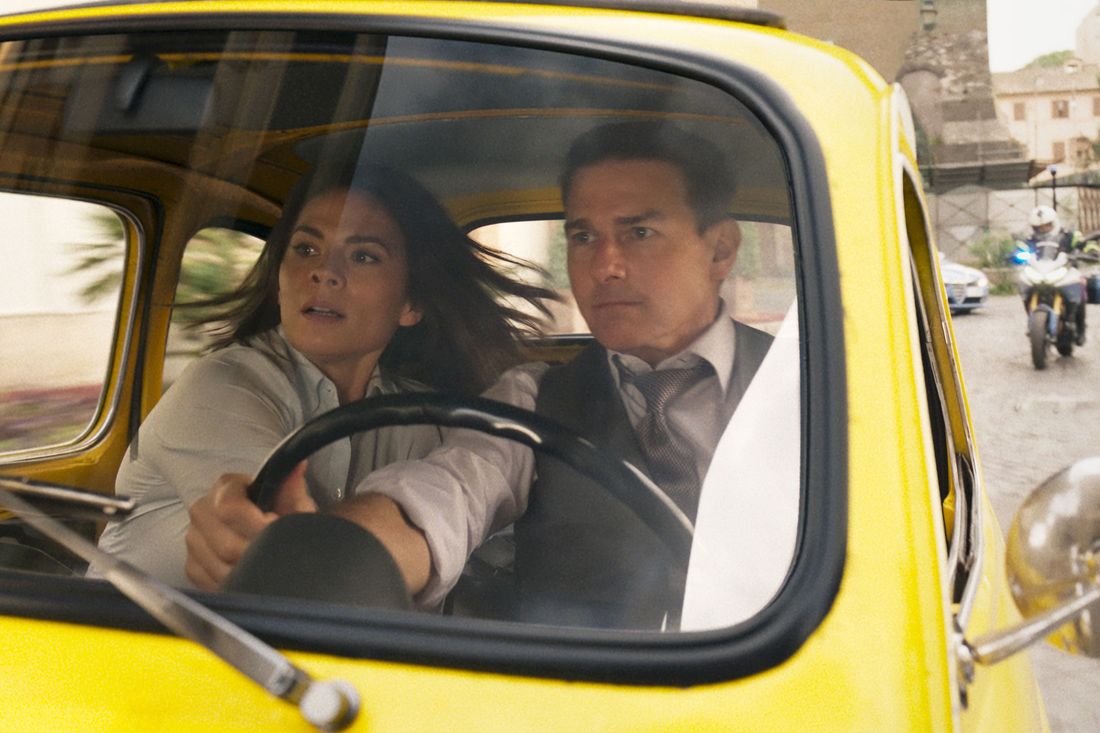
In 2011, the Mission: Impossible films shifted from action story vehicles of varying quality and narrative coherence to unapologetic stunt spectaculars with one clear reason to see them: Tom Cruise risking his life to entertain you. But Ghost Protocol and its antecedents — 2015’s Rogue Nation and 2018’s Fallout, the fifth and sixth entries into the franchise, respectively — didn’t just propose audiences watch the savior of cinema dangle from various extremely high things on any screens, they suggested audiences do so on the biggest, most dynamic screens they could possibly find. A decade ago, that meant IMAX. Today, with the seventh M:I movie upon us, there are myriad options: you can see Dead Reckoning Part One on a big screen (Standard Digital Projection), on a gigantic screen (IMAX), on a really big screen (RPX), on a stretched (ScreenX), or in pure chaos (4DX). To help you avoid choice paralysis, I spent the better part of one week watching Dead Reckoning in every format available to me in New York City. Here’s what I learned, five screens and 14 mostly wonderful hours later.
.
Option #1: The Big Screen
What Is Standard Digital Projection?
You know when it’s Saturday afternoon and you go to a movie, one in which Tom Cruise isn’t running through a city on the other side of the world to stop a baddie from blowing something up? Or, how about this, you know when you buy a ticket for whatever’s playing and the price is what you expect it to be and the experience feels like a movie has always felt, only with significantly less film grain than you remember from your childhood? That’s standard digital projection.
Why Should I See Dead Reckoning in Standard Digital Projection?
Because the price is what you expect it to be and the experience feels like a movie has always felt, only with significantly less film grain than you remember from your childhood. There are no upcharges and no surprises when you use your Regal Unlimited Pass to see Mission: Impossible on a regular big screen. The rate of failure on this mission is low. It’s like asking Ethan Hunt to build an IKEA bookshelf. No crew needed, no threat of mass death, and you’re lowkey impressed when he does the part recommended for two people … all by himself.
Why Shouldn’t I See Dead Reckoning in Standard Digital Projection?
Because a Premium Large Format (PLF) screen like IMAX, RPX, or Dolby Cinema is nearby.
.
Option #2: The Gigantic Screen
What Is IMAX?
IMAX standing for Image Maximum is as ridiculous as the IMF standing for Impossible Mission Force. IMAX was primarily used for short documentary films until Christopher Nolan decided to shoot roughly half an hour of 2008’s The Dark Knight on large, loud, unwieldy, and expensive IMAX cameras. The resulting images aren’t just clearer, thanks to the film stock (65mm, as opposed to traditional 35mm film), they are taller (IMAX screens take up a more square-like 4:3 ratio, as opposed to a wider, more typical 2.39:1).
So which M:I movies were intended to be experienced in IMAX? Some, but not all, of Ghost Protocol and Fallout, was shot on 65mm film and so the movie is described as “filmed for IMAX.” Dead Reckoning used IMAX-certified cameras, but not 65mm film, and is therefore described as “shot for IMAX.” Rogue Nation was only “digitally re-mastered into the image and sound quality of an IMAX Experience.” It’s all a bit confusing. (Just take a look at this press release explaining Dune’s two very different IMAX experiences or this interview in which Christopher Nolan details the many ways to see Oppenheimer!) The catch: only films shot on IMAX’s 65mm film were actually meant to fill that very tall IMAX screen.
Why Should I See Dead Reckoning in IMAX?
None of Tom Cruise’s death defying acts in Dead Reckoning were filmed to fill a several-story screen, but there’s another selling point to the IMAX experience: the sound quality. An acoustically refined IMAX theater absolutely envelops audiences in dialogue, sound effects, and score. If you must spend roughly twice the amount of a standard movie ticket, this is the best way to experience Dead Reckoning. So just let that IMAX propaganda pour over you. By the time you’ve gone from the box office to the ticket taker to the concession stand to the actual auditorium, you’ll have passed so many IMAX logos and IMAX movie posters that you’ll never watch an Image Minimum movie again.
Why Shouldn’t I See Dead Reckoning in IMAX?
Consider your bladder. The bigger the screen, the longer the rows of seats; so if you’re feeling the repercussions of that Cherry Coke Zero after Ethan Hunt feels the repercussions of that first meeting with Kittridge some thirty years ago, keep in mind that you’ll be stepping over more unmoving knees than you ever thought possible while making your way to the aisle.
.
Option #3: The Really Big Screen
What Is RPX?
RPX, Regal’s premium large format brand, stands for “Regal Premium Experience.” They describe the system as “a giant immersive screen… illuminated by high-quality digital projectors and completed with a state-of-the-art sound system.” Yes, it’s an opportunity to charge a premium on an already-high movie ticket, and an acronym like RPX sounds like some kind of scam, but this (like IMAX and AMC’s Dolby Cinema), isn’t a gimmick. The difference between RPX and standard projection is apparent not long after sitting down — even trailers you’ve seen countless times before are given new life.
Why Should I See Dead Reckoning in RPX?
Because it really does look, sound, and feel that much better than Standard Digital Projection. I’m not sure if there are actual rumbling devices in the seats or if the subwoofers are simply that powerful, but I find the kind of subtle grumble during Dead Reckoning to be perfectly immersive in this format. And I can’t stress this enough: know your bladder. This movie is two hours and forty-five minutes. Getting up and sneaking out isn’t treacherous when your auditorium has generous walking space. If you’re seeing Dead Reckoning in RPX, feel free to make your Pepsi Zero a large.
Why Shouldn’t I See Dead Reckoning in RPX?
Because one of the few remaining IMAX screens is nearby. If you can get to one of those, it simply trumps RPX. Though most PLF screens — be it RPX (Regal), Dolby Cinema (AMC), or those retrofitted “LIEMAX” screens — are better than Standard.
.
Option #4: The Stretched Screen
What is ScreenX?
ScreenX is the funniest thing to happen to the movies since Buster Keaton. A con artist really convinced hundreds of theaters to chop their films into three pieces and call the whole thing a “premium experience.” Because this isn’t the gentle roundness of a planetarium or domed IMAX screen — it’s a movie projected across three white walls connected at 90-degree angles. There’s nothing graceful about ScreenX! This piece referred to the experience as “IMAX but sideways.” Which is to say… it’s disorienting. You’re constantly tempted to look at the side screens but never rewarded for the effort. I’ve seen two movies in this format, both of which were visually spectacular — Elvis and Dead Reckoning — and can confidently say the peculiar cropping and jarring stretching of the frame’s edges was at best a distraction, and at worst just plain ugly.
Why Should I See Dead Reckoninge in ScreenX?
I don’t know, because you subscribe to Variety, listen to The Town, or are just really into the wackadoo business of Hollywood? Because the other screenings sold out and this is the last possible showing at the last possible theater on the last possible day that you can see it? Ethan Hunt himself would find it impossible to enjoy a movie like this.
Why Shouldn’t I See Dead Reckoning in ScreenX?
The ScreenX projection of Dead Reckoning reminded me of an HFR (High Frame Rate) projection, which tends to make things uncomfortably smooth and textureless. Chase scenes that looked stunning in all the other formats had an uncanny veneer in ScreenX, as if I could make out every individual layer of CGI. What felt like a true blockbuster in other formats felt more like an expensive episode of television projected in someone’s basement in ScreenX. Even worse, the sound seemed to be coming exclusively from the front of the auditorium, as if the surround mix had been condensed into simple stereo. A common plea from action movie marketers these days is to “SEE OUR MOVIE ON THE BIGGEST SCREEN POSSIBLE.” They’re right, and that’s a good line. You know what isn’t a good line? “SEE OUR MOVIE ON THE LONGEST SCREEN POSSIBLE, PROJECTED FROM THREE PROJECTORS ONTO THREE WALLS, TWO OF WHICH ARE BASKING IN RED GLOW OF ‘EXIT’ SIGNS BECAUSE NOT EVEN THE MAGIC OF CINEMA CAN OVERRIDE FIRE CODE.”
.
Option #5: Utter Chaos
What Is 4DX?
There’s a scene in Fallout when an IMF courier delivers a message to Ethan in his safehouse. Their authenticating call and response goes like this:
Courier: Fate whispers to the warrior…
Ethan: A storm is coming.
Courier: And the warrior whispers back…
Ethan: I am the storm.
4DX is that storm.
There’s a scene in Dead Reckoning when Jasper Biggs (Shea Whigam) prepares his unit for the difficulty of capturing Ethan Hunt by calling him a “mind-reading, shape-shifting incarnation of chaos.”
4DX is that mind-reading, shape-shifting incarnation of chaos.
It combines the very basic act of watching a movie (sitting, looking, listening) with the sense overload of an amusement park ride that’s overdue for inspection (swaying, shaking, wetness, chill, desperation for it all to end). Large seats with retractable footrests are synchronized to the action on screen, creating a distressing ballet of three primary experiences: movement (the chairs rock from side to side and front to back and the seat backs are like roided-out massage devices, prodding you in the general area where a character is receiving a punch or kick onscreen), wind (if there’s wind in a scene, it will be windy in the theater), and mist (if someone gets wet in a scene, you will be sprayed in the face like a misbehaving cat). A handful of other auditorium-wide effects — like flashing lights, scent infusions, and fog — are less overwhelming and, honestly, sort of nice.
A story: When I was a teenager, my family stopped in Las Vegas for one night on the way to Yosemite National Park from central Texas. We stayed at the Excalibur, a casino designed with children in mind. While my parents gambled, the casino allowed my sister and I to rent one (1) Pay-Per-View movie in the hotel and gave us some cash to spend in the Excalibur arcade. We watched Beautician and the Beast in the room, laughed our asses off, and then proceeded to the games, where I spent like $15 of my $20 on a machine that strapped me into a moving seat and screened a 10-minute movie action sequence. At the time I thought, “It would be so amazing to watch a full-length film like this.” But, like children often are, I was totally wrong.
Why Should I See Dead Reckoning in 4DX?
If you’ve (1) already seen Dead Reckoning in a reasonable format, and (2), after having reading this, understand that I wholeheartedly do not recommend it. If at this point you remain morbidly curious and incapable of getting the idea of 4DX out of your twisted little mind, there’s nothing I can do to save you. Go for it, freak.
Why Shouldn’t I See Dead Reckoning in 4DX?
I spilled an ounce or so of Pepsi Zero on myself during one of the first seat rumblings, leaving me afraid of my Pepsi Zero for the next two and a half hours. Imagine being afraid of your Pepsi Zero! The nonstop wind effect during a scene in the Arabian desert was so cold it numbed my fingertips for the remainder of the movie. Because the screening was nearly empty, the intermittent bangs of dozens and dozens of retractable footrests falling was jarring. During a relentless chase sequence in Rome, it almost felt like Regal Union Square was going to collapse right into the N/Q/R/W line. 4DX is fantastic for horror movies, where the jolts and jostles only add to the surprise of a jumpscare. I could see it being sort of fun for a more typical action movie that takes occasional breaks from the insanity. But for a movie like this, one that almost never gives its characters time to breathe, 4DX is a stomach issue waiting to happen.


